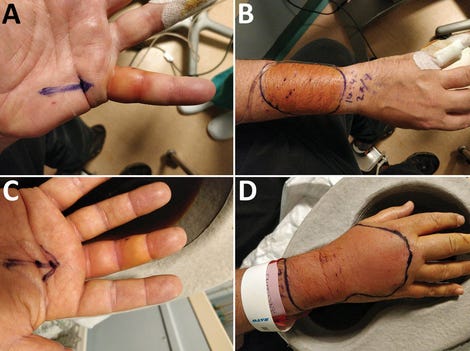A man in the UK has become a medical first, though not in a great way. In a recent paper, scientists say he’s the first known person to have caught a newly discovered bacteria from a stray cat’s bite. Though the feline encounter resulted in a gnarly infection of his hands, the man was eventually treated successfully and made a full recovery.
The case was detailed in the August issue of the journal Emerging Infectious Diseases.
According to the paper, the 48-year-old man visited doctors with painful swelling in both hands, merely eight hours after he was bitten multiple times by a single feral cat. The man’s wounds were cleaned and dressed, he was given a precautionary tetanus booster, and he was sent home with antibiotics. Unfortunately, he returned to the emergency department just 24 hours later as his infection continued to worsen. This time, doctors surgically removed the man’s dead and infected tissue and placed him on intravenous antibiotics. Following another course of oral antibiotics, he made a full recovery.

In trying to figure out the exact cause of the man’s infection, the authors found microbes inside his wounds that resembled Streptococcus, a well-known group of bacteria that occasionally sicken people. But upon closer examination, the likely culprit didn’t have a direct genetic match to any known species of bacteria. The team then decided to sequence the bacteria’s entire genome and finally determined that the man had contracted a wholly novel germ.
The bacteria seems to be a member of the genus Globicatella. Until now, two species of Globicatella bacteria have been identified, with only one species known to rarely cause human disease. Cases of human Globicatella infection have caused some concern since the bacteria have shown reduced susceptibility to some commonly used antibiotics. But thankfully, most of the antibiotics that the authors tested against this new species in the lab did appear effective.
While this case has a happy ending, the authors say it’s a cautionary tale. Cuddly as cats can be, their bites and scratches should be taken seriously, especially if they pierce the skin. It isn’t just the potential germs in a cat’s mouth or paws that make these bites and scratches dangerous, but the delivery method. A cat’s claws and teeth can cause small but deep puncture wounds, which then seal up quickly and trap bacteria under the skin. These dangers are all the more elevated for people with weakened immune systems, including the elderly (in this case, the man seemed to have normal immune function).
“In conclusion, cat bites are common sources of zoonotic infection. This report highlights the role of cats as reservoirs of as yet undiscovered bacterial species that have human pathogenic potential,” the authors wrote.
Cat bites in general should be cleaned immediately with running water and soap. People should also see a doctor as soon as possible since serious infections can arise within 24 hours or sooner.
